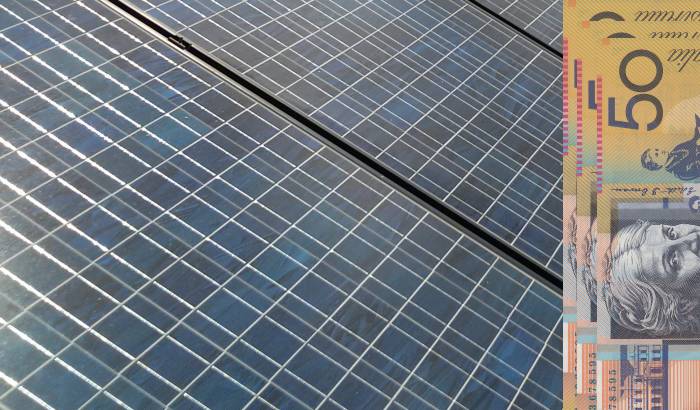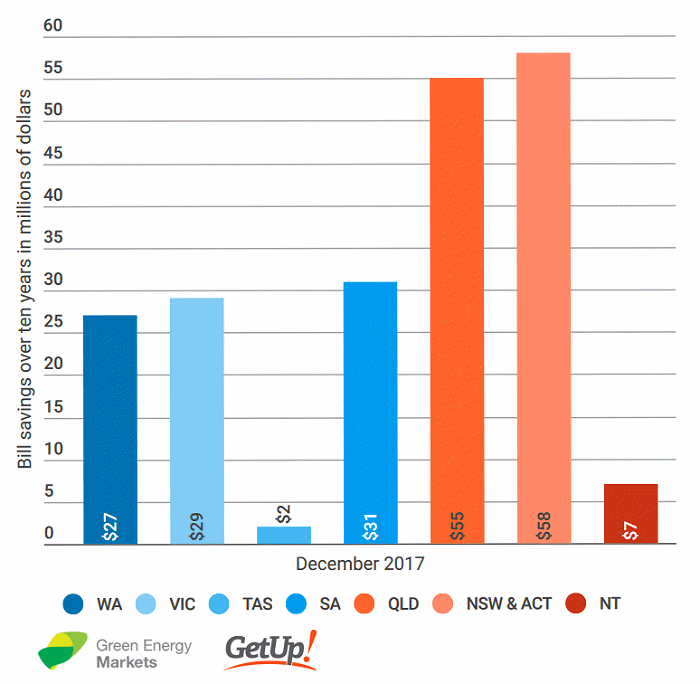
Solar panel image: B137,CC BY-SA 4.0
Rooftop solar panels installed last year across Australia will deliver an estimated $2 billion in electricity bill savings over the next decade states the latest Renewable Energy Index.
Released earlier today by Green Energy Markets and GetUp!, the Index indicates Australians installed 1,078 megawatts worth of rooftop solar systems last year, breaking the previous annual record set in 2012.
Enough rooftop solar was installed in December 2017 alone to power 29,730 homes and will generate an estimated $209 million in power bill savings over the next ten years.
As well as providing clean electricity and slashing power bills, the 16,247 systems installed throughout December supported an estimated 5,477 full-time jobs in solar power system design, installation and sales.
In terms of utility-scale renewable energy, wind and solar farm projects committed last year will generate more than 10,000 gigawatt-hours of electricity annually when developed. The report states if this level of capacity investment was maintained for another decade, it would be enough to supply close to two-thirds of the nation’s expected 2030 electricity consumption.
Whether that level will be sustained remains to be seen, with the Clean Energy Regulator reporting earlier this week Australia will meet its 2020 Renewable Energy Target ahead of schedule and the road ahead unclear at a federal level. However, some states will continue to be heavy lifters with their own ambitious renewable energy targets, along with ongoing residential solar uptake and interest in commercial-scale PV gaining steam.
As with small-scale solar, large-scale renewables are continuing to be a significant employer. The Index states the 4,417 megawatts of projects currently under construction in Australia in December will create enough jobs to employ 15,691 people on a full-time basis – but many of these jobs won’t be on a permanent basis.
Renewables (all types) represented 16.3% of mains grid electricity generated (west & east coast grids) in December, and was enough to power 6.9 million homes.
GetUp! has an active petition calling on governments to commit to 100% renewable energy by 2030, stopping big energy companies ripping off Australians and implementing a solid plan for the orderly closure of coal-fired power stations.
“It’s clear: the best thing to reduce pollution and blackouts is a smart, modern electricity grid based on 100% clean energy,” says GetUp!.
The petition can be accessed here, the December 2017 Renewable Energy Index summary here and full report (including methodology) here (PDF).


 RSS - Posts
RSS - Posts



We could , yes, save a lot. I could save $200 a quarter but Origin Energy can’t possibly install a net meter for me to go onto a net tariff because of this and that, and it seems private electricians aren’t allowed to instal (“tamper with”) them, and they give a different reason every time I ask. Sometimes they don’t have the supply of new meters, next time they don’t have enough manpower to keep up with demand. I am so greedy, trying to get in ahead of others who have priority, etc, you name it. They are dragging their heels every bit of the way!
Hi There I installed a solar system late last year and my last bill was $6.20 ! Happy Days. However I do have a question. I have a 6kw system and my friend has 4.5Kw. The maximum I can produce in a day is 29.9Kw yet his system produces 45Kw – why is this?
Producing around 30 kilowatt-hours on a clear day with a 6 kilowatt solar system is reasonable. Producing 45 kilowatt-hours in a day with a 4.5 kilowatt system is pretty much impossible. Or at least on earth it is. My guess is some figures have gotten confused.
Maybe the system is on a two-axis tracker?
Or, if it’s on the rooftop like everyone else’s… maybe the HOUSE is on a two-axis tracker?
Even a two axis tracker won’t do the trick. Concentration could do it, but that would be hard to overlook.